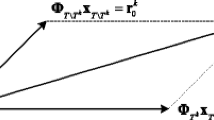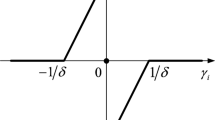Abstract
This paper analyzes some properties of the alternating separation (AS) and alternating projection (AP) algorithm. The analysis shows that AS converges to the optimal point steadily but slowly, while AP converges to the optimal point quickly but is prone to immersing into the local extreme of the maximum likelihood (ML) criterion. To avoid their disadvantages and make use of their advantages, ASAP, which is the combination of AS and AP, is proposed. Simulation results show that the ASAP algorithm has the ability of estimating the direction of arrival more accurately and converging to optimal point more quickly.
Similar content being viewed by others
References
Stoica, P., Nehorai, A., MUSIC, Maximum likelihood and Cramer-Rao bound, IEEE Trans on. ASSP-37, 1989, (5): 720–741.
Hwang, J. K., Chen, Y. C., Super-resolution frequency estimation by alternating notch periodogram, IEEE Trans. on SP, 1993, 41(2): 727–741.
Mather, J. L., Characterization of the iterative multi-parameter algorithm, Proceedings of the Institute of Acoustics part B, 1989, 11: 180–197.
Shao Chao, Bao Zheng, RELAX, Maximum likelihood and its relationship algorithm, Journal of Xi’dian Uni. (in Chinese), 1997, 24 (12): 124–132.
Ziskind, I., Wax, M., Maximum likelihood location of multiple sources by alternating projection, IEEE Trans on. ASSP-36, 1988, (10): 1553–1560.
Shao Chao, Bao Zheng, The improvement of the RELAX algorithm, Journal of Electronics (in Chinese), 1998, 20 (1): 26–33.
Shao Chao, Lu Guangyue, The basic theory analysis of alternating separation algorithm, System Engineering and Electronics (in Chinese), 2001, 23 (7): 12–14.
Author information
Authors and Affiliations
Corresponding author
Rights and permissions
About this article
Cite this article
Shao, C., Lu, G. & Bao, Z. Some properties of the alternating separation (AS), alternating projection (AP) and ASAP algorithm. Sci China Ser F 47, 409–420 (2004). https://doi.org/10.1007/BF02901655
Received:
Revised:
Issue Date:
DOI: https://doi.org/10.1007/BF02901655




